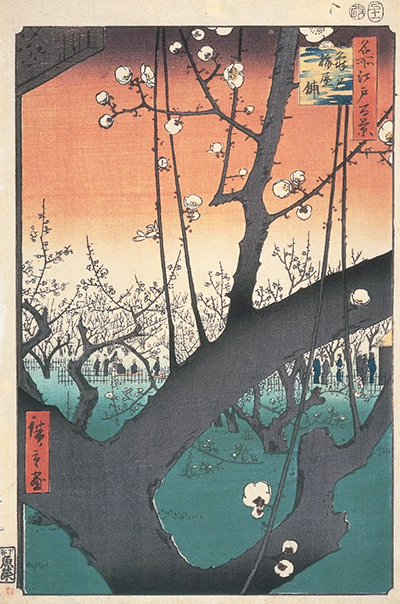Plum Park in Kameido was published in 1857 and comes from Hiroshige's world-famous One Hundred Famous Views of Edo series. The image of trees blooming is typical of Japanese art from this period.
This was an artist who regularly placed elements dominantly in the foreground, essentially framing the rest of the content and he does so again here. The thick grey branches are imposed upon the viewer, but he then allows brighter colours to show through from behind. A gradiented red sky fades down to the horizon and lifts this piece to a new level of brightness. There are then the flower buds that appear along some of the smaller branches, captured in white without too much detail. They contrast with the unfriendly tones of dark grey and offer a more upbeat atmosphere of life and growth. Further back is a further array of trees, though much smaller as the artist imposes perspective. It is also helps us to understand the nature of our environment, which is a small plot with multiple trees placed fairly close together. There is a small house to the right hand side as well as a number of figures who also help to underline the feeling of perspective through to the back of the scene.
Hiroshige adored the Japanese landscape and used it as inspiration for much of his work. You will find a great variety of views around this stunning country across his various series of work. The woodblock prints produced could be distributed far and wide, allowing many more people to learn and appreciate the qualities of artists such as this. Plum Park in Kameido was actually the 30th installment within the One Hundred Famous Views of Edo series and the combination of the red tones with the blooming flowers appear to have made it amongst the most popular from this selection of work. As an example of how far and wide this print would go, Van Gogh would have his own copy within Europe and even produced a version of it within one of his paintings. Japanese art would influence a good number of European painters, some of whom loved to collect these different woodblock prints whenever they became available.
There has been a huge interest in Japanese art within the west in recent years, particularly with the public who find many of these iconic images to be charming and also beautifully feminine. Many will now be aware of the work of both Hokusai and Hiroshige, even though they may not necessarily know the identities of the artists themselves. Those who take the time to look more deeply into the background around these artworks will likely find many more that interest them from other parts of each artist's oeuvre. There has always been a bit of a magical curious nature to the nation of Japan within western eyes, and its contribution to art has always been amongst its more significant cultural contributions. In recent years this has developed onwards with cartoon art as well as an influence in digital gaming, that has been present in the country now for several decades and continues to grow as an industry on an annual basis.




